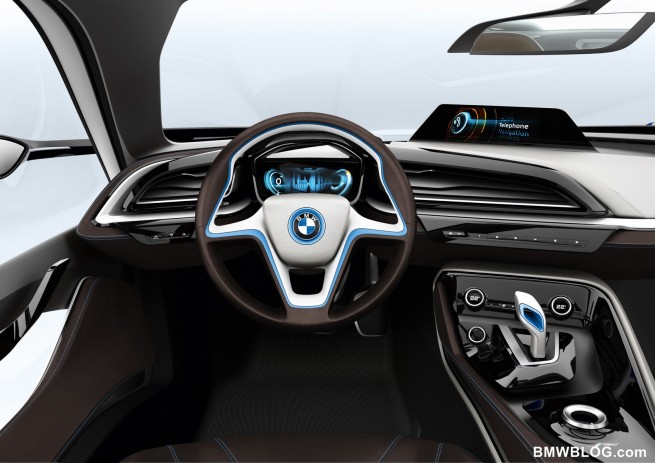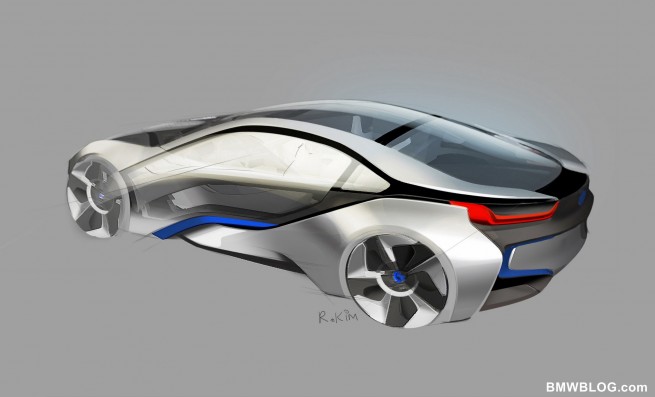Editorial: The BMW i8 – Sustainable Magic
What can you say about a car that is quick as an M3 and returns 75 MPG. It’s a killer idea, almost crazy, and yet we’ll see production BMW i8s in the very near future. And BMW will pull this sustainable magic off without resorting to unobtainium metallurgy, perpetual motion schemes, or unicorn droppings.
BMW has taken the idea of a plug-in hybrid and turned it up to ’11′. And it’s done within the boundaries of the ‘i’ sub-brand, sustainable EfficientDynamics. It is truly a sibling of the i3.
The i8′s layout of chassis and passenger cell is a bit different than the i3′s, however. The i8 uses a smaller battery pack and it goes into a central tunnel – again kept as low as possible. The tunnel splits the driver and passenger side of the car. It looks like a central backbone design with sub-frames fore and aft for motors and suspension.
There is nothing new here. If you go back to the early ’20s the great designer Ledwinka built a Tatra around a central backbone chassis (Tatra, now there’s a great subject – maybe at a later date, and we’ll explore L & K and Skoda while we’re at it). And of course, Lotus pulled the same rabbit out of their hat with the ’60s era Elan.
But the magic BMW brings to the party is the CFRP production process that will make up the core of the passenger cell. The outer skin will be composed of thermoplastic (and that allows almost instant life cycle impulses – or customization). Regardless, the ‘i’ sub-brand layering design idiom will be at the fore.
The interior will define sporty – any Prius owner sitting in this car will be ‘green’ with envy. The i8 will redefine what can be done with a hybrid. Hopefully the instrumentation won’t be biased towards hypermiling. But the interior, thanks to the wide central tunnel, will echo exotic cars of yore.
There is nothing exotic under the hood(s) though. BMW will use it new 500cc per cylinder architecture three cylinder gas engine. It displaces 1500cc (of course), uses direct injection, dual VANOS and Valvetronic, and is turbo-charged. The upshot is that the three cylinder returns 220+ HP, 220+lb-ft of torque.
The electric motor is a tweaked version of the motor in the i3. It’s optimized for operation in conjunction with the gasoline engine and produces 184 lb-ft of torque. They may be limiting the RPM of the electric motor and that could be due to the need to synchronize the two separate drivetrains.
That’s another piece of magic this car has going for it. It can be front wheel drive, rear wheel drive, or all wheel drive. And there is no transfer case mucking up the works (and adding weight). Instead there are tons of function points (hello to all the computer programmers out there) that keep things swimming together in harmony.
That need to synchronize using heavily linked software also means that wetware (the human brain) has to be taken out of the shifting equation. The car comes with an automatic transmission without an option for a manual. The parameters of the transmission’s operation have to be under the ECUs control. And they’ve yet to perfect the Vulcan mind meld needed to get the ECU controlling a driver’s hands and feet.
But the real magic of the i8 is that BMW has taken new production processes – that are used for the i3 also currently – and engines that are part of the corporate portfolio, they’ve wrapped a tremendously exciting design around the interior and exterior and subsequently can charge dearly for them. They will not be short of customers. But there is nothing truly ‘trick’ about these cars. No titanium mudflaps, no carbon nano-structure curb feelers, and no micro-fiber fuzzy dice. It’s just EfficientDynamics to another order of magnitude. We can’t wait to drive one.





Author: Hugo Becker
Source: http://www.bmwblog.com/2011/08/12/edito ... ble-magic/





























